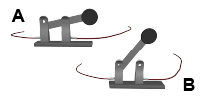- What conditions are required for electric current to flow?
- Two tanks are each half full of water. What condition is necessary for the water to flow from one to the other? What is the analogous necessary condition for electric current in a conductor?
- What flows through a circuit?
- Imagine you have only a wire. Do electric charges flow through it? Why or why not?
- Is voltage or current measured across a circuit?
- Yuri was trying to use his 5 V power supply (a voltage source) for a light bulb circuit. He connected the red plug to his bulb, but it did not light. How was he using the power supply incorrectly?
- Does voltage or charge flow through a circuit?

- Which of these knife blade switches creates an electrical connection across it?
- Why should you not insert both leads of a lamp into the same row of a circuit breadboard?
- If you need a variable voltage, is it better to use a battery or a power supply?
- When you are using copper wire to prototype a circuit, why is it better to use plastic-coated wire than bare wire?
 Raymundo tried to illuminate a mini-lamp by touching its two leads to the positive terminal at the top of a battery. Did he succeed? Raymundo tried to illuminate a mini-lamp by touching its two leads to the positive terminal at the top of a battery. Did he succeed?
 Describe how the energy of water behind a dam is analogous to the energy in a battery. Describe how the energy of water behind a dam is analogous to the energy in a battery.
 You are given three 1.5 V batteries, one resistor, and wires to connect them. Draw a circuit diagram to show how you can create a voltage of 4.5 V across the resistor. You are given three 1.5 V batteries, one resistor, and wires to connect them. Draw a circuit diagram to show how you can create a voltage of 4.5 V across the resistor.
 Why do birds sitting on high-voltage power lines not get electrocuted? Why do birds sitting on high-voltage power lines not get electrocuted?
- What is the purpose of a wire cutter tool?
| | - If the resistance of a resistor is unchanged but the current through it doubles, how does the voltage across the resistor change?
- Which materials listed below are good conductors?
- aluminum
- rubber
- copper
- gold
- diamond
- How do you connect the data acquisition probes for a digital multimeter to measure the voltage in a circuit?
 Which of the following circuit elements typically has a measurable resistance: a wire, a switch, a battery, a lamp, and/or a resistor? Which of the following circuit elements typically has a measurable resistance: a wire, a switch, a battery, a lamp, and/or a resistor?
 To measure the voltage across a resistor, do you connect the voltmeter in series or parallel with the resistor? To measure the voltage across a resistor, do you connect the voltmeter in series or parallel with the resistor?
 If the resistance of a resistor is doubled while the voltage across it is held constant, how does the current through the resistor change? If the resistance of a resistor is doubled while the voltage across it is held constant, how does the current through the resistor change?
 How are voltage, current, and resistance related to each other? How are voltage, current, and resistance related to each other?
 How would you characterize the resistance of an open circuit? How would you characterize the resistance of a short circuit? How would you characterize the resistance of an open circuit? How would you characterize the resistance of a short circuit?
 To measure the current through a resistor, do you connect the ammeter in series or parallel with the resistor? To measure the current through a resistor, do you connect the ammeter in series or parallel with the resistor?
 Describe how water flowing downward through the open neck of a bottle of water is analogous to the resistance of a resistor in an electric circuit. Describe how water flowing downward through the open neck of a bottle of water is analogous to the resistance of a resistor in an electric circuit.
 Why are electrical wires usually covered by a layer of plastic? Why are electrical wires usually covered by a layer of plastic?
 Why shouldn’t you use an electrical device while in the shower or bathtub? Why shouldn’t you use an electrical device while in the shower or bathtub?
 If the resistance of a resistor is halved and the voltage across it is also halved, how does the current through the resistor change? If the resistance of a resistor is halved and the voltage across it is also halved, how does the current through the resistor change?
 Should the part of a light switch that you touch be a good conductor or insulator? Why? Should the part of a light switch that you touch be a good conductor or insulator? Why?
 Air is not a good conductor of electricity. How might our lives be different if air were a good conductor? Air is not a good conductor of electricity. How might our lives be different if air were a good conductor?
|

